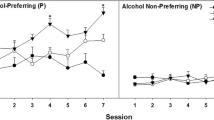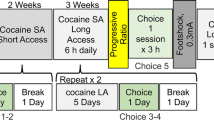Abstract
Selectively breeding lines of mice and rats to differ in alcohol intake has proven useful for defining which traits correlate with high alcohol drinking behavior, as well as for creating animal models of alcoholism. This study reports the derivation of two novel sets of selected lines, High Alcohol Preferring (HAP) and Low Alcohol Preferring (LAP) replicate 2 and 3 lines. Mice were mass-selected using the same procedure as in the replicate 1 lines: using HS/Ibg as a progenitor, mice were selected for differences in 2-bottle choice intake of 10% alcohol during a 4-week testing period. In addition, another high-drinking line, the crossed HAP (cHAP) line was selectively bred from a progenitors that were a cross of replicate 1 (S27) × replicate 2 (S21) HAP lines. All lines were characterized for saccharin intake. Overall, the response to selection of the HAP and LAP replicate 2 and 3 lines was quite similar. As anticipated, following selection, the cHAP line drank more than either parent HAP line (consuming 26.0 g/kg per day of alcohol by S11), suggesting that this method of crossing replicate lines and selecting from that cross captures more alleles than any single selected line, as well as producing a line with exceptionally high voluntary alcohol intake. As expected, saccharin consumption was highly associated with alcohol consumption; data from 7 lines (HAP 1, 2, and 3, LAP 1, 2, and 3, and cHAP) indicated a genetic correlation between 10% alcohol and 0.32% saccharin intake of 0.91. Overall, these findings show the practicality of developing replicate lines divergent in alcohol preference, and validate a novel procedure for generating very high-drinking mouse populations.








Similar content being viewed by others
References
Agabio R, Carai MA et al (2000) Dissociation of ethanol and saccharin preference in sP and sNP rats. Alcohol Clin Exp Res 24(1):24–29
Belknap JK, Crabbe JC et al (1993) Voluntary consumption of ethanol in 15 inbred mouse strains. Psychopharmacology 112(4):503–510
Belknap JK, Richards SP et al (1997) Short-term selective breeding as a tool for QTL mapping: ethanol preference drinking in mice. Behav Genet 27(1):55–66
Bice PJ, Foroud T et al (2006) Identification of QTLs influencing alcohol preference in the High Alcohol Preferring (HAP) and Low Alcohol Preferring (LAP) mouse lines. Behav Genet 36(2):248–260
Bice P, Valdar W et al (2009) Genomewide SNP screen to detect quantitative trait Loci for alcohol preference in the high alcohol preferring and low alcohol preferring mice. Alcohol Clin Exp Res 33(3):531–537
Blednov YA, Metten P et al (2005) Hybrid C57BL/6J × FVB/NJ mice drink more alcohol than do C57BL/6J mice. Alcohol Clin Exp Res 29(11):1949–1958
Blednov YA, Ozburn AR et al (2010) Hybrid mice as genetic models of high alcohol consumption. Behav Genet 40(1):93–110
Carroll ME, Morgan AD et al (2008) Selective breeding for differential saccharin intake as an animal model of drug abuse. Behav Pharmacol 19(5–6):435–460
Chester JA, Lumeng L et al (2003) High- and low-alcohol-preferring mice show differences in conditioned taste aversion to alcohol. Alcohol Clin Exp Res 27(1):12–18
Colombo G (1997) ESBRA-Nordmann 1996 Award Lecture: ethanol drinking behaviour in Sardinian alcohol-preferring rats. Alcohol Alcohol 32(4):443–453
Crabbe JC (1989) Genetic animal models in the study of alcoholism. Alcohol Clin Exp Res 13(1):120–127
Crabbe JC, Phillips TJ et al (1990) Estimation of genetic correlation: interpretation of experiments using selectively bred and inbred animals. Alcohol Clin Exp Res 14(2):141–151
Crabbe JC, Metten P et al (2009) A line of mice selected for high blood ethanol concentrations shows drinking in the dark to intoxication. Biol Psychiatry 65(8):662–670
Crawley JN (2007) What’s wrong with my mouse? Behavioral phenotyping of transgenic and knockout mice. Wiley-Interscience, Hoboken, NJ
Dess NK, Badia-Elder NE et al (1998) Ethanol consumption in rats selectively bred for differential saccharin intake. Alcohol 16(4):275–278
Eriksson K (1968) Ethyl alcohol consumption: valid measurement in albino rats. Science 161(836):76–77
Falconer DS, Mackay TFC (1996) Introduction to quantitative genetics. Addison Wesley Longman, Essex
Flint J, Valdar W et al (2005) Strategies for mapping and cloning quantitative trait genes in rodents. Nat Rev Genet 6(4):271–286
Foroud T, Bice P et al (2002) Mapping of QTL influencing saccharin consumption in the selectively bred alcohol-preferring and -nonpreferring rat lines. Behav Genet 32(1):57–67
Goldman D, Oroszi G et al (2005) The genetics of addictions: uncovering the genes. Nat Rev Genet 6(7):521–532
Grahame NJ (2000) Selected lines and inbred strains. Tools in the hunt for the genes involved in alcoholism. Alcohol Res Health 24(3):159–163
Grahame NJ, Li TK et al (1999) Selective breeding for high and low alcohol preference in mice. Behav Genet 29(1):47–57
Green AS, Grahame NJ (2008) Ethanol drinking in rodents: is free-choice drinking related to the reinforcing effects of ethanol? Alcohol 42(1):1–11
Grisel JE, Metten P et al (2002) Mapping of quantitative trait loci underlying ethanol metabolism in BXD recombinant inbred mouse strains. Alcohol Clin Exp Res 26(5):610–616
Jacquot C, Croft AP et al (2008) “Effects of the glucocorticoid antagonist, mifepristone, on the consequences of withdrawal from long term alcohol consumption. Alc Clin Exp Res 32(12):2107–2116
Kampov-Polevoy AB, Kasheffskaya OP et al (1996) Pain sensitivity and saccharin intake in alcohol-preferring and -nonpreferring rat strains. Physiol Behav 59(4–5):683–688
Kampov-Polevoy A, Garbutt JC et al (1997) Evidence of preference for a high-concentration sucrose solution in alcoholic men. Am J Psychiatry 154(2):269–270
Kampov-Polevoy AB, Garbutt JC et al (1999) Association between preference for sweets and excessive alcohol intake: a review of animal and human studies. Alcohol Alcohol 34(3):386–395
Kranzler HR, Sandstrom KA et al (2001) Sweet taste preference as a risk factor for alcohol dependence. Am J Psychiatry 158(5):813–815
Le AD, Israel Y et al (2001) Genetic selection for high and low alcohol consumption in a limited-access paradigm. Alcohol Clin Exp Res 25(11):1613–1620
Li TK, Lumeng L et al (1993) Selective breeding for alcohol preference and associated responses. Behav Genet 23(2):163–170
Lu K, McDaniel AH, Tordoff MG et al (2005) “No relationship between sequence variation in protein coding regions of the Tas1r3 gene and saccharin preference in rats. Chem Senses 30(3):231–240
Lumeng L, Hawkins TD et al (1977) Alcohol and aldehyde metabolizing systems. Academic Press, New York
Mardones J, Segovia-Riquelme N (1983) Thirty-two years of selection of rats by ethanol preference: UChA and UChB strains. Neurobehav Toxicol Teratol 5(2):171–178
Mennella JA, Pepino MY et al (2010) Sweet preferences and analgesia during childhood: effects of family history of alcoholism and depression. Addiction 105(4):666–675
Murphy JM, Stewart RB et al (2002) Phenotypic and genotypic characterization of the Indiana University rat lines selectively bred for high and low alcohol preference. Behav Genet 32(5):363–388
Oberlin BG, Grahame NJ (2009) High alcohol preferring mice are more impulsive than low alcohol preferring mice as measured in the delay discounting task. Alcohol Clin Exp Res 33(7):1–10
Phillips TJ, Crabbe JC et al (1994) Localization of genes affecting alcohol drinking in mice. Alcohol Clin Exp Res 18(4):931–941
Phillips TJ, Shen EH et al (2002) Forward, relaxed, and reverse selection for reduced and enhanced sensitivity to ethanol’s locomotor stimulant effects in mice. Alcohol Clin Exp Res 26(5):593–602
Rodriguez LA, Plomin R et al (1995) Alcohol acceptance, preference, and sensitivity in mice. II. Quantitative trait loci mapping analysis using BXD recombinant inbred strains. Alcohol Clin Exp Res 19(2):367–373
Sinclair JD, Kampov-Polevoy A et al (1992) Taste preferences in rat lines selected for low and high alcohol consumption. Alcohol 9(2):155–160
Stewart RB, Russell RN et al (1994) Consumption of sweet, salty, sour, and bitter solutions by selectively bred alcohol-preferring and alcohol-nonpreferring lines of rats. Alcohol Clin Exp Res 18(2):375–381
Tampier L, Quintanilla ME (2005) Saccharin consumption and the effect of a long-term exposure to a sweetened alcoholic solution in high- (UChB) and low- (UChA) alcohol-drinking rats. Alcohol 37(1):47–52
Tremblay KA, Bona JM et al (2009) Effects of a diagnosis or family history of alcoholism on the taste intensity and hedonic value of sucrose. Am J Addict 18(6):494–499
Waller MB, McBride WJ et al (1982) Induction of dependence on ethanol by free-choice drinking in alcohol-preferring rats. Pharmacol Biochem Behav 16(3):501–507
Waller MB, McBride WJ et al (1983) Initial sensitivity and acute tolerance to ethanol in the P and NP lines of rats. Pharmacol Biochem Behav 19(4):683–686
Yoneyama N, Crabbe JC et al (2008) Voluntary ethanol consumption in 22 inbred mouse strains. Alcohol 42(3):149–160
Acknowledgments
This work was supported by the Indiana Alcohol Research Center (P60 07611) to David Crabb, U01 AA13483 to NJG, and F31 AA016430 to BGO. Thanks are also extended to Lawrence Lumeng, who initiated selection of replicate 1 HAP and LAP mice.
Author information
Authors and Affiliations
Corresponding author
Additional information
Edited by Tamara Phillips.
Rights and permissions
About this article
Cite this article
Oberlin, B., Best, C., Matson, L. et al. Derivation and Characterization of Replicate High- and Low-Alcohol Preferring Lines of Mice and a High-Drinking Crossed HAP Line. Behav Genet 41, 288–302 (2011). https://doi.org/10.1007/s10519-010-9394-5
Received:
Accepted:
Published:
Issue Date:
DOI: https://doi.org/10.1007/s10519-010-9394-5




